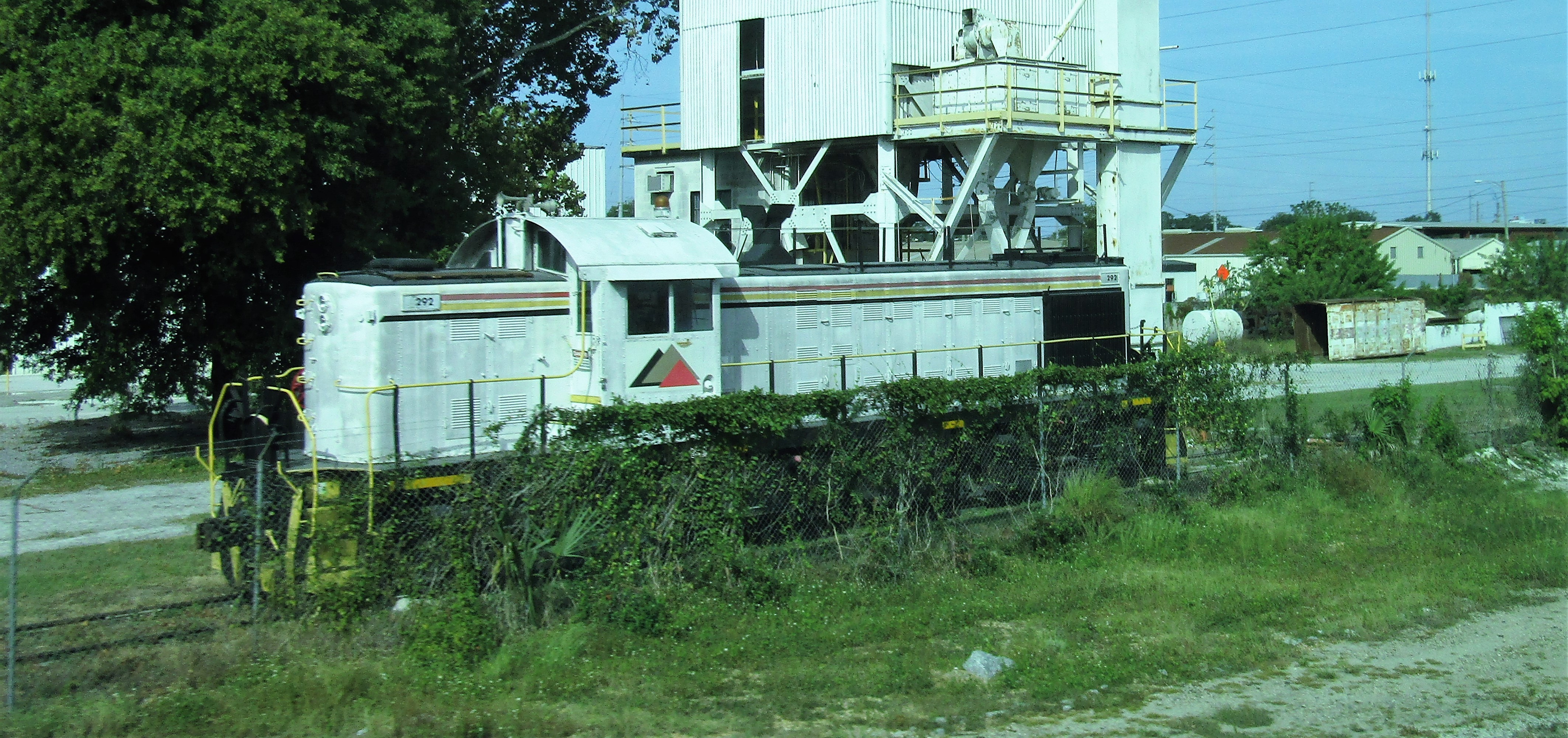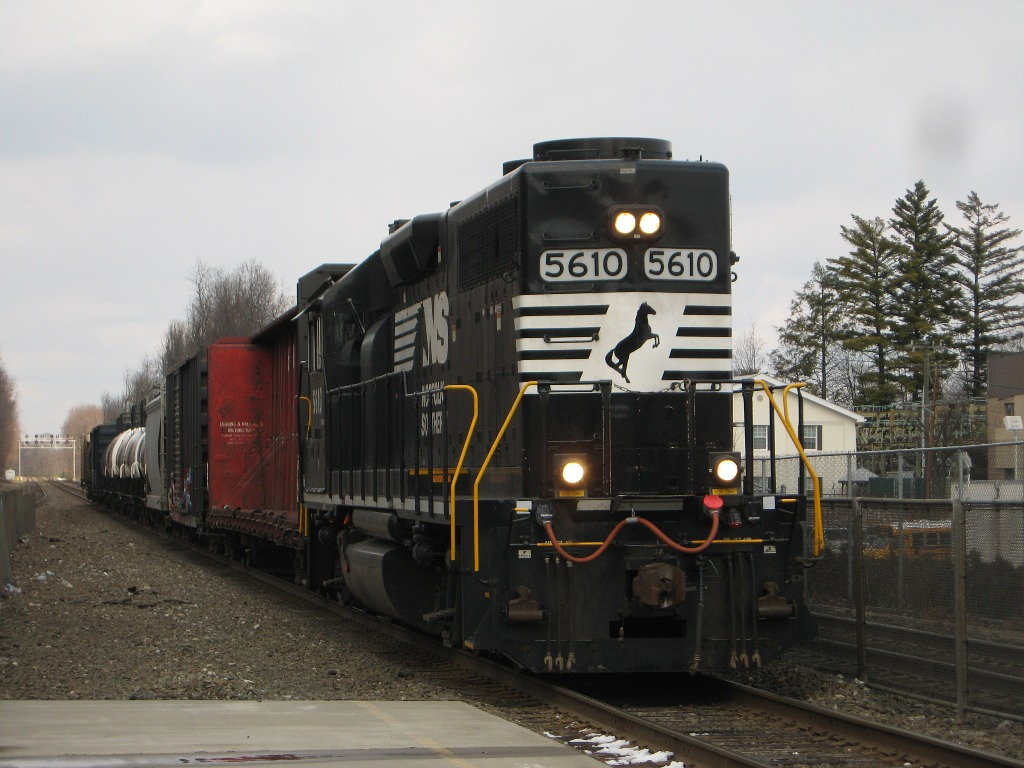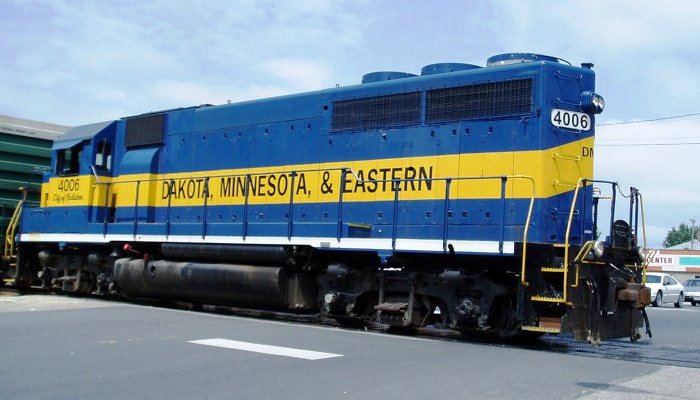|
ALCO RS-1
The ALCO RS-1 is a 4-axle diesel-electric transmission, diesel-electric locomotive built by Alco-GE between 1941 and 1953 and the American Locomotive Company from 1953 to 1960. ALCO subsidiary Montreal Locomotive Works built an additional three RS-1s in 1954. This model has the distinction of having the longest production run of any diesel locomotive for the North American market. The RS-1 was in production for 19 years from the first unit Rock Island #748 in March 1941 to the last unit National of Mexico #5663 in March 1960. Design In 1940, the Rock Island Railroad approached ALCO about building a road switcher locomotive, for both road and switching service. To meet the Rock Island's request, ALCO created the RS-1. Their new design was a hood unit, in contrast to most existing locomotive designs at the time which were predominantly cab unit, carbody units. The hood unit design allowed for improved visibility, especially to the rear. Rear visibility is very important for Shunti ... [...More Info...] [...Related Items...] OR: [Wikipedia] [Google] [Baidu] |
Railway Air Brake
A railway air brake is a railway brake power braking system with compressed air as the operating medium. Modern trains rely upon a fail-safe air brake system that is based upon a design patented by George Westinghouse on April 13, 1869. The Westinghouse Air Brake Company was subsequently organized to manufacture and sell Westinghouse's invention. In various forms, it has been nearly universally adopted. The Westinghouse system uses air pressure to charge air reservoirs (tanks) on each car. Full air pressure causes each car to release the brakes. A subsequent reduction or loss of air pressure causes each car to apply its brakes, using the compressed air stored in its reservoirs. Overview Straight air brake In the air brake's simplest form, referred to as a ''straight air system'', compressed air is directed to a ''brake cylinder'', causing its piston to apply force to mechanical linkage, which linkage is conventionally referred to as the ''brake rigging'' (see illu ... [...More Info...] [...Related Items...] OR: [Wikipedia] [Google] [Baidu] |
Bogie
A bogie ( ) (or truck in North American English) comprises two or more Wheelset (rail transport), wheelsets (two Railroad wheel, wheels on an axle), in a frame, attached under a vehicle by a pivot. Bogies take various forms in various modes of transport. A bogie may remain normally attached (as on many railroad cars and semi-trailers) or be quickly detachable (as for a dolly (trailer), dolly in a road train or in railway bogie exchange). It may include Suspension (vehicle), suspension components within it (as most rail and trucking bogies do), or be solid and in turn be suspended (as are most bogies of continuous track, tracked vehicles). It may be mounted on a swivel, as traditionally on a railway carriage or locomotive, additionally jointed and sprung (as in the landing gear of an airliner), or held in place by other means (centreless bogies). Although ''bogie'' is the preferred spelling and first-listed variant in various dictionaries, bogey and bogy are also used. Rail ... [...More Info...] [...Related Items...] OR: [Wikipedia] [Google] [Baidu] |
ALCO RSD-1
The ALCO RSD-1 is a diesel-electric locomotive built by the American Locomotive Company (ALCO). This model was a road switcher type rated at and rode on three-axle trucks, having a C-C wheel arrangement. It was often used in much the same manner as its four-axle counterpart, the ALCO RS-1, though the six-motor design allowed better tractive effort at lower speeds, as well as a lower weight-per-axle. It was developed to meet the need to supply the Soviet Union over the Trans-Iranian Railway starting in mid 1943. On the other hand, due to the traction generator and appurtenant control apparatus being sized for four axles and yet having two additional powered axles, it had poorer performance at higher speeds.Rakov (1995), p. 371-374. Variations There were three different specifications issued that covered the RSD-1 model; E1645 and E1646 were for wartime production for the US Army, while E1647 was a post-war order for the Mexican National Railways ( Ferrocarriles Nacionales de ... [...More Info...] [...Related Items...] OR: [Wikipedia] [Google] [Baidu] |
Soviet Union
The Union of Soviet Socialist Republics. (USSR), commonly known as the Soviet Union, was a List of former transcontinental countries#Since 1700, transcontinental country that spanned much of Eurasia from 1922 until Dissolution of the Soviet Union, it dissolved in 1991. During its existence, it was the list of countries and dependencies by area, largest country by area, extending across Time in Russia, eleven time zones and sharing Geography of the Soviet Union#Borders and neighbors, borders with twelve countries, and the List of countries and dependencies by population, third-most populous country. An overall successor to the Russian Empire, it was nominally organized as a federal union of Republics of the Soviet Union, national republics, the largest and most populous of which was the Russian SFSR. In practice, Government of the Soviet Union, its government and Economy of the Soviet Union, economy were Soviet-type economic planning, highly centralized. As a one-party state go ... [...More Info...] [...Related Items...] OR: [Wikipedia] [Google] [Baidu] |
Trans-Iranian Railway
The Trans-Iranian Railway () was a major railway building project started in Pahlavi Iran in 1927 and completed in 1938, under the direction of the then-Iranian monarch Reza Shah. It was entirely built with indigenous capital, and links the capital Tehran with Bandar Shahpur (now: Bandar-e Emam Khomeyni) on the Persian Gulf in the south and Bandar Shah (now: Bandar Torkaman) on the Caspian Sea in the north, via Ahvaz and Ghom. In 1961, under Reza Shah's son Mohammad Reza Pahlavi, it was extended from Bandar Shah to a new terminus in Gorgan. During the land reforms of Mohammad Reza Pahlavi in 1963, as part of the "White Revolution", the Trans-Iranian railway was extended to link Tehran to Mashhad, Tabriz and Isfahan. The original 1938 Bandar Shahpur-to-Bandar Shah route was designated as a UNESCO World Heritage Site in July 2021. Before World War I: the Russian scheme The idea of a railway connecting the Russian Empire and British India was proposed by several private Russian ... [...More Info...] [...Related Items...] OR: [Wikipedia] [Google] [Baidu] |
World War II
World War II or the Second World War (1 September 1939 – 2 September 1945) was a World war, global conflict between two coalitions: the Allies of World War II, Allies and the Axis powers. World War II by country, Nearly all of the world's countries participated, with many nations mobilising all resources in pursuit of total war. Tanks in World War II, Tanks and Air warfare of World War II, aircraft played major roles, enabling the strategic bombing of cities and delivery of the Atomic bombings of Hiroshima and Nagasaki, first and only nuclear weapons ever used in war. World War II is the List of wars by death toll, deadliest conflict in history, causing World War II casualties, the death of 70 to 85 million people, more than half of whom were civilians. Millions died in genocides, including the Holocaust, and by massacres, starvation, and disease. After the Allied victory, Allied-occupied Germany, Germany, Allied-occupied Austria, Austria, Occupation of Japan, Japan, a ... [...More Info...] [...Related Items...] OR: [Wikipedia] [Google] [Baidu] |
Long Hood
The long hood of a hood unit-style diesel locomotive is, as the name implies, the longer of the two hoods (narrower sections of the locomotive body in front and behind of the cab) on a locomotive, particularly American-type freight locomotives. Equipment The long hood normally contains the diesel engine (prime mover), the main generator or alternator, the locomotive's cooling radiators, the dynamic brake resistor grids if fitted, and most of the locomotive's auxiliary equipment. Head-end power equipment, if fitted, is normally in the long hood; steam generators for heating older passenger cars may be either in the long or short hoods. Operating direction Normally, the long hood is the rear of the locomotive. For early hood unit models, this was not the case; railroads preferred to run with the long hood at the front and the cab at the rear (referred to as operating long hood forward or LHF). This is a holdover from the steam era of railroads where almost all locomotives were ... [...More Info...] [...Related Items...] OR: [Wikipedia] [Google] [Baidu] |
Shunting (rail)
Shunting, in railway operations, is the process of sorting items of rolling stock into complete trains, or the reverse. In the United States this activity is known as switching. Motive power Motive power is normally provided by a locomotive known as a ''shunter locomotive'' (in the UK) or switcher locomotive (in the US). Most shunter/switchers are now diesel-powered but steam and even electric locomotives have been used. Where locomotives could not be used (e.g. because of weight restrictions) shunting operations have in the past been effected by horses or capstans. Hazards Coupling The terms "shunter" and "switcher" are not only applied to locomotives but also to employees engaged on the ground with shunting/switching operations. The task of such personnel is particularly dangerous because not only is there the risk of being run over, but on some railway systems—particularly ones that use buffer-and-chain/screw coupling systems—the shunters have to get between the ... [...More Info...] [...Related Items...] OR: [Wikipedia] [Google] [Baidu] |
Cab Unit
In North American railroad terminology, a cab unit is a railroad locomotive with its own cab and controls. "Carbody unit" is a related term, which may be either a cabless booster unit controlled from a linked cab unit, or a cab unit that contains its own controls. Characteristics With both body styles, a bridge-truss design framework is used to make the body a structural element of the locomotive. The body extends the full width and length of the locomotive. The service walkways are inside the body. Carbody units, gaining rigidity from the body trusswork, require less structural weight to achieve rigidity than do locomotives with non-structural bodies. For that reason, carbody construction was favored to increase the power-to-weight ratio for early diesel locomotives, before the power available with diesel technology was increased. Recent years have seen carbody construction revived in the quest for greater fuel efficiency with passenger locomotives. The full-width body ... [...More Info...] [...Related Items...] OR: [Wikipedia] [Google] [Baidu] |
Hood Unit
A hood unit, in North American railroad terminology, is a body style for diesel and electric locomotives where the body is less than full-width for most of its length and walkways are on the outside. In contrast, a cab unit has a full-width carbody for the length of the locomotive and walkways inside. A hood unit has sufficient visibility to be operated in both directions from a single cab (locomotive), cab. Also, the locomotive frame is the main load-bearing member, allowing the hood to be non-structural and easily opened or even removed for maintenance. History The hood unit evolved from the switcher locomotive. A switcher's long hood is normally low enough that the crew can see over it, and there typically is no short hood. American Locomotive Company, Alco introduced the road switcher concept with the ALCO RS-1, RS-1, which was an enlarged switcher with a short hood ahead of the cab. This was added to provide protection for the crew in case of a collision. The low long ho ... [...More Info...] [...Related Items...] OR: [Wikipedia] [Google] [Baidu] |
Road Switcher Locomotive
A road switcher locomotive is a type of railroad locomotive designed to both haul railcars in mainline service and shunt them in railroad yards. Both type and term are North American in origin, although similar types have been used elsewhere. A road switcher must be able to operate and have good visibility in both directions. As a road engine, a road switcher must be able to operate at road speeds, with suitable power and cooling capacity. It has high-speed road trucks rather than low-speed switcher only trucks. Modern road trucks are always equipped with "frictionless" roller bearings, whereas switcher trucks were almost always equipped with "friction" plain bearings, until plain bearings were outlawed in interchange service on both railcars and locomotives. Overview For the reasons given above, road switchers are generally hood units. The set-back cab of a hood unit provides more safety in the event of a collision at speed than most switcher locomotive designs, and the ... [...More Info...] [...Related Items...] OR: [Wikipedia] [Google] [Baidu] |









